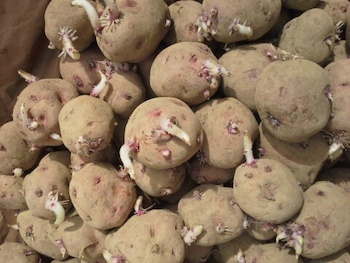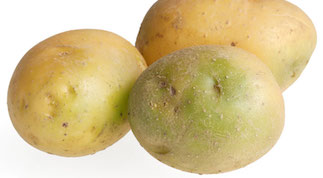Easy-Grow Survival Spuds
By Janet Scheren, Fairfax Master Gardener Intern
 Ask any gardener what foods would be on their list of must grow survival foods, and it’s a sure bet the potato will be near the top. But like so much of our food stock today, the tasty potato has a long and complicated history with man, being transformed from an inedible, poisonous tuber to one that has saved whole populations from starvation in times of famine. Potatoes originated in the Peruvian highlands more than 6,000 years ago. There the local population used taste to detect the levels of toxic glycoalkaloids in potatoes to determine the safety of various cultigens. They also developed cooking techniques to make it not only edible but a delicious food staple. Potatoes began their spread throughout the world around 1570. Sailors returning from the Andes brought them to Spain, followed shortly by introduction into the British Isles. Today more than 5,000 potato varieties are grown worldwide.
Ask any gardener what foods would be on their list of must grow survival foods, and it’s a sure bet the potato will be near the top. But like so much of our food stock today, the tasty potato has a long and complicated history with man, being transformed from an inedible, poisonous tuber to one that has saved whole populations from starvation in times of famine. Potatoes originated in the Peruvian highlands more than 6,000 years ago. There the local population used taste to detect the levels of toxic glycoalkaloids in potatoes to determine the safety of various cultigens. They also developed cooking techniques to make it not only edible but a delicious food staple. Potatoes began their spread throughout the world around 1570. Sailors returning from the Andes brought them to Spain, followed shortly by introduction into the British Isles. Today more than 5,000 potato varieties are grown worldwide.
Starchy, Waxy, All-Purpose: A Potato for Every Culinary Use
Potatoes can be grouped into three broad categories: starchy, waxy and all-purpose. Starchy potatoes, such as Russet, are high in starch but low in moisture. They tend to be oblong and have coarse skin. They are great baked or fried. Waxy potatoes have smooth, thin skin, high moisture content and less starch. They hold together when boiled and are great in soups, casseroles and potato salad. Many Fingerling potatoes fall in this category along with Red Bliss, Pontiac and New Potatoes. All-purpose potatoes have a starch level halfway between the other two and hold up well in most recipes. They are particularly great for roasting, pan frying and gratins. Well known all-purpose potatoes include Yukon Gold, Kennebec and a range of blue and purple potatoes. The anthocyanins in blue potatoes provide added antioxidant value.
Cultural Practices
Potatoes grow best in full sun with well-drained soil high in organic matter with a pH of 6.0 to 6.5. In Virginia, plant early potatoes between March 15 and April 20. Potatoes grow rapidly in cool spring weather. Hard frosts, however, will retard growth, and seed pieces will languish or rot if planted during prolonged cold weather. Crops can be planted as late as June for fall harvest. Soil temperature above 80 degrees inhibit tuber development.

Seed potatoes
Begin the process with quality seed potatoes. Seed potatoes are not seeds. To be certified as seed potatoes, these potatoes are inspected in the field throughout the growing season and the winter to check for disease and to ensure that varieties are true to type. They are also screened for disease contamination. They should be firm and unsprouted. Each seed potato can produce multiple potato plants by chitting them. Set the seed potatoes out in a cool room with bright indirect light for one to three weeks to develop eyes between ½ inch and 1 inch long. Then cut these potatoes into pieces no smaller than an egg with two or more eyes. Hold the pieces for a day so the cuts dry, then plant them out.
Potatoes can be grown as an early crop for new potatoes and as a late crop for storage. Choose an early-maturing variety and a medium- to late-maturing variety for a more continuous harvest. Avoid a garden site that was turned under from a lawn as grubs can damage the developing tubers. Uniform soil moisture is also critical, especially while tubers are developing. Potatoes are medium-heavy feeders, so add a high phosphorus fertilizer of 5-10-5 before planting. Then sidedress once or twice after tubers begin forming with a balanced fertilizer of 10-10-10.
Potatoes can be planted several ways – in furrows, hilled rows, covered with straw, raised beds or containers. Regardless of the method, plant chitted seed pieces cut side down, 3- to 5-inches deep. Late crops should be planted 5- to 6-inches deep. When the tops grow 6 inches above the soil, cover — or hill up — soil around the base of each plant to shield tubers from the sun, which can cause greening or scalding. Repeat this process — whether the potatoes are going in the soil or a container — when the plant adds an additional 6 inches of growth.
 Green Is Dangerous
Green Is Dangerous
Green portions (chlorophyll) on a potato contain a bitter, poisonous alkaloid, which helps the plant defend against dangerous organisms like fungi and bacteria. This occurs when tubers are exposed to sunlight triggering photosynthesis — both in the garden or postharvest. Because the stem and leaves also contain these compounds, you can plant potatoes around the border of your garden to deter deer and other pests. But don’t let those compounds become an issue in your kitchen. If tubers are exposed to sunlight, they begin photosynthesis and turn green. Any green part of the potato should be cut off and discarded. This is why it’s important to keep the tubers below ground as they grow and to store them out of sunlight postharvest.
Just Say No to Blight
Potatoes are famously susceptible to blight. Start by purchasing seed potatoes from disease resistant varieties. Supermarket potatoes can be infected with diseases without exhibiting any symptoms. Saving your own seed potatoes is problematic because viruses and diseases often show up the following year. A pH of 6.0 to 6.5 is best for potatoes; however, lowering it to between 5.0 and 5.2 can deter scab disease. Growing potatoes in soil bags or containers with new soil avoids nematodes, grubs and soil-borne disease that might have overwintered in your garden.
Potatoes are also threatened by insect pests — primarily the Colorado potato beetle, flea beetle and leaf hoppers. Crop rotation is an important strategy to minimize infestation by these pests. Two strains of a non-toxic Bt bacteria will control potato beetles: Bacillus thuringiensis ssp.san diego and B. thuringiensis ssp. tenebrionis, a form of Bt that is not genetically engineered. Neem oil is useful in controlling leaf hoppers.
How to Harvest and Store
Gently dig the soil around the young potatoes with a garden fork to avoid damaging the plant and bruising or spearing tubers. Bruises and cuts sustained during the harvest will allow entry of soil-borne fungi and bacteria that cause storage rots.
If you plan to store potatoes, leave tubers in the ground for two weeks after plants die back so they can develop a thickened skin. Don’t dig potatoes if the soil is wet. Gently knock off attached soil when harvesting but don’t wash tubers prior to storage. If you plan to store potatoes, cure them for 10 to 14 days at 50 to 60 degrees and high humidity to heal over wounds and cuts. They can be stored in medium cool (40 to 50 degrees), moist (90 percent relative humidity) conditions for 6 to 8 months in ventilated bags or boxes out of the light to prevent greening.
Resources
Potatoes, Peppers and Eggplant, Diane Relf and Alan McDaniel, Virginia Cooperative Extension
Potatoes, Home & Garden Information Center, University of Maryland Extension
The Powerful Solanaceae, US Forest Service, US Department of Agriculture
Solanine, Wikipedia
How The Potato Changed The World, Charles C. Mann, Smithsonian Magazine, Nov 2011
“Grow Great Virginia Vegetables,” Ira Wallace, 2020, Timber Press